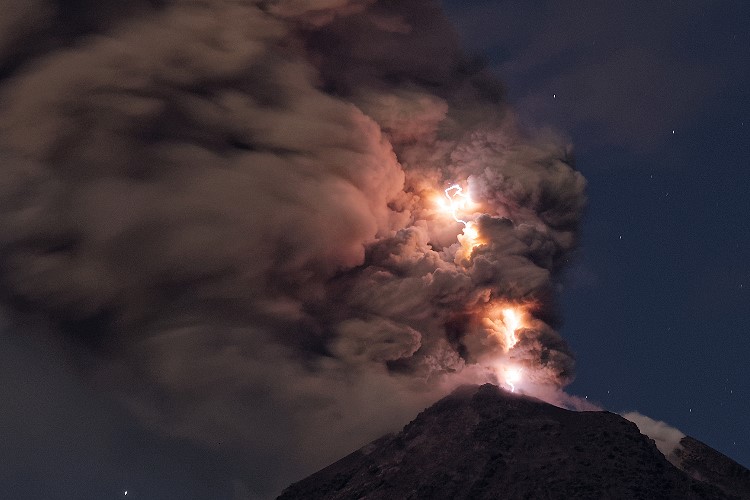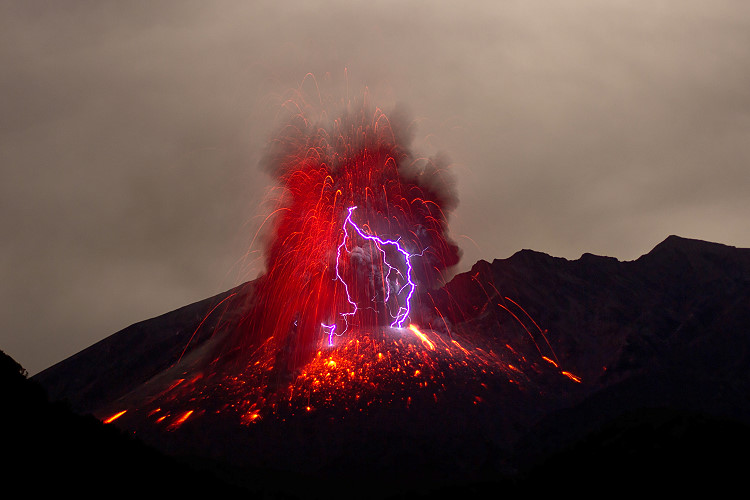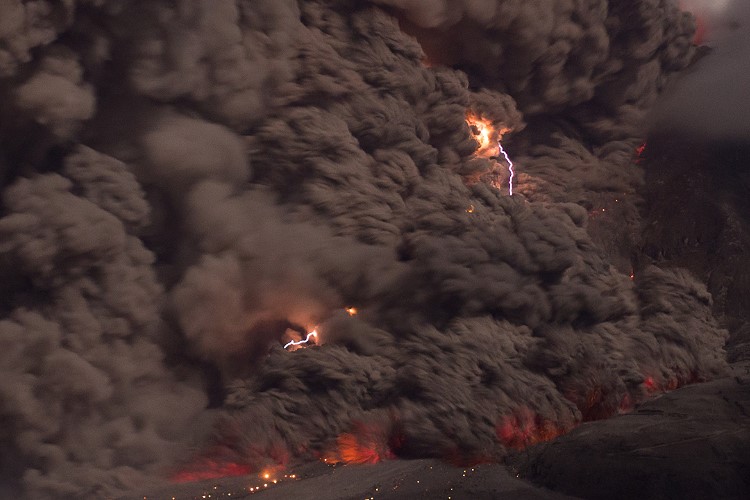Volcanic thunderstorms occur especially in the eruption clouds of volcanic and plinian eruptions. Occasionally, volcanic lightning also occurs during smaller eruptions: at Sakura-jima, Anak Krakatau and Etna I could already observe occasional flashes in the ash clouds of strombolian eruptions. The flashes mostly formed between 5 and 10 seconds after the explosion. At Sinabung volcano lightning appeared in the fast rising ash clouds of pyroclastic flows.
pictures of volcanic flashes

volcanic lightning at the Colima.

volcanic thunderstorm at Sinabung.

volcanic thunderstorm at Sinabung.
The initial velocity of the rising tephra is crucial for the occurrence of volcanic lightning. During strombolian eruptions, lightning occurred mainly when the eruption cloud rose unusually fast, when the gas pressure of the explosion was particularly high. The friction of the ash grains creates an electric field that is discharged in the lightning. Another factor could be the grain size of the volcanic ash. The finer the ash, the greater the potential for lightning. During the day, the electrical discharges in an eruption cloud are hardly visible, but can be heard! I can only faintly recall thunderstorm rumbles, what sticks in my memory is the crackling sound of static electricity that makes the hairs on your neck stand up.
Scientific investigation of volcanic lightnings
However, scientific studies of this natural phenomenon are quite rare, because even in large eruptions lightning does not necessarily occur. So it seems to depend also on the atmospheric conditions whether volcanic thunderstorms occur or not. Ronald Thomas from the NMT in Socorro investigated this question in January 2006 at Mount St. Augustine in Alaska and installed two measuring instruments at a distance of 100 km from the volcano. These recorded the direction of radio wave emissions generated by electrical discharges. On January 28, Augustine erupted and produced 4 major eruptions, of which ash clouds rose several kilometers high. The detectors registered two phases of electrical discharges in the first eruption cloud. First, at the beginning of the eruption, countless micro-discharges were registered directly above the crater, which culminated in some very energetic flashes. From this the researchers concluded that the hot tephra already had a strong positive charge in the conveyor vent.
During a second lightning phase, which started about 3 minutes after the first explosion, Thomas registered more than 300 flashes emanating from the eruption cloud. The longest flash was 15 km long. This volcanic storm resembled a conventional one. Besides the residual electrical charge of the tephra from the initial stage of the eruption, electrical charges built up in the ash cloud due to the collision of the ash particles. Similar things happen during normal thunderstorms in clouds when ice crystals collide.
In addition, the measuring instruments registered a lightning bolt about 4 km long, which shot vertically into the sky from the summit of the volcano and then broke off horizontally into the drifting ash cloud. This allows the conclusion that negative charges built up at the summit itself, which discharged into a positively charged ash cloud.
Volcanic lightning also plays a role in a theory of the origin of life on earth. The processes by which inorganic matter is transformed into organic molecules have now been partially simulated in laboratory experiments. As early as 1953, the chemists Miller and Urey proved in their "primordial soup experiment" that amino acids and fatty acids are formed from ammonia, hydrogen and methane when energy is supplied to them in the form of lightning. But this only works under the influence of a reducing environment, i.e. an atmosphere without free oxygen. However, the sensitive building blocks of life decay quickly under such conditions. For them to remain stable, one thing is necessary: Water!
Conditions, as they are necessary for the origin of life, existed only near primeval volcanoes. There, not only the necessary inorganic compounds were concentrated, but also the necessary reducing milieu prevailed. In addition, the volcanoes spewed out water in the form of water vapor, which quickly condensed on fine particles. When energy is supplied in the form of lightning, which is often associated with volcanic eruptions, stable organic molecules are actually formed under these conditions.
